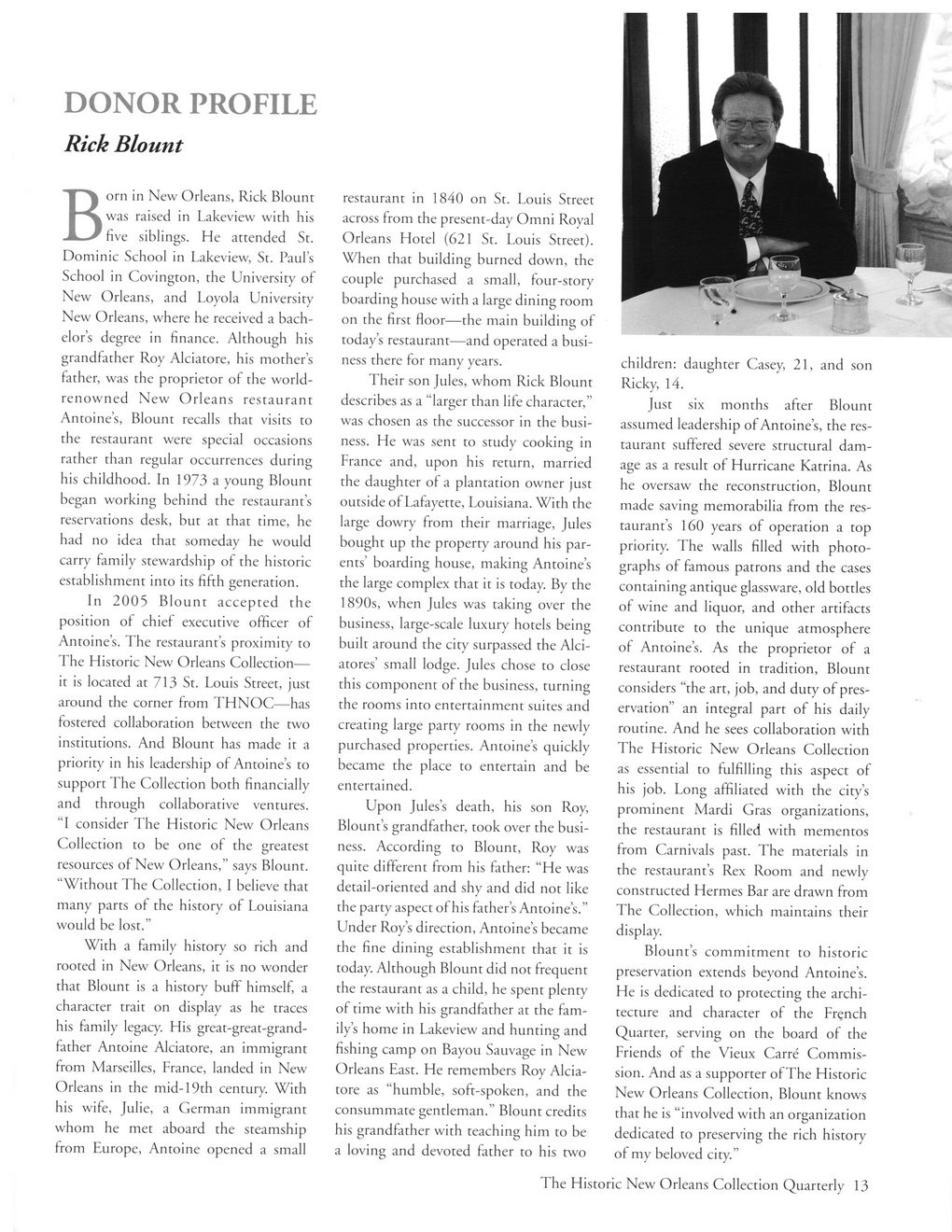This text was obtained via automated optical character recognition.
It has not been edited and may therefore contain several errors.
DONOR PROFILE Rick Blount Born in New Orleans, Rick Blount was raised in Lakeview with his five siblings. He attended St. Dominic School in Lakeview, St. Paul’s School in Covington, the University of New Orleans, and Loyola University New Orleans, where he received a bachelor’s degree in finance. Although his grandfather Roy Alciatore, his mother’s father, was the proprietor of the world-renowned New Orleans restaurant Antoine’s, Blount recalls that visits to the restaurant were special occasions rather than regular occurrences during his childhood. In 1973 a young Blount began working behind the restaurant’s reservations desk, but at that time, he had no idea that someday he would carry family stewardship of the historic establishment into its fifth generation. In 2005 Blount accepted the position of chief executive officer of Antoine’s. The restaurant’s proximity to The Historic New Orleans Collection— it is located at 713 St. Louis Street, just around the corner from THNOC—has fostered collaboration between the two institutions. And Blount has made it a priority in his leadership of Antoine’s to support The Collection both financially and through collaborative ventures. “I consider The Historic New Orleans Collection to be one of the greatest resources of New Orleans,” says Blount. “Without The Collection, I believe that many parts of the history of Louisiana would be lost.” With a family history so rich and rooted in New Orleans, it is no wonder that Blount is a history buff himself, a character trait on display as he traces his family legacy. His great-great-grand-father Antoine Alciatore, an immigrant from Marseilles, France, landed in New Orleans in the mid-19th century. With his wife, Julie, a German immigrant whom he met aboard the steamship from Europe, Antoine opened a small restaurant in 1840 on St. Louis Street across from the present-day Omni Royal Orleans Hotel (621 St. Louis Street). When that building burned down, the couple purchased a small, four-story boarding house with a large dining room on the first floor—the main building of today’s restaurant—and operated a business there for many years. Their son Jules, whom Rick Blount describes as a “larger than life character,” was chosen as the successor in the business. He was sent to study cooking in France and, upon his return, married the daughter of a plantation owner just outside of Lafayette, Louisiana. With the large dowry from their marriage, Jules bought up the property around his parents’ boarding house, making Antoine’s the large complex that it is today. By the 1890s, when Jules was taking over the business, large-scale luxury hotels being built around the city surpassed the Alci-atores’ small lodge. Jules chose to close this component of the business, turning the rooms into entertainment suites and creating large party rooms in the newly purchased properties. Antoine’s quickly became the place to entertain and be entertained. Upon Jules’s death, his son Roy, Blount’s grandfather, took over the business. According to Blount, Roy was quite different from his father: “He was detail-oriented and shy and did not like the party aspect of his father’s Antoine’s.” Under Roy’s direction, Antoine’s became the fine dining establishment that it is today. Although Blount did not frequent the restaurant as a child, he spent plenty of time with his grandfather at the family’s home in Lakeview and hunting and fishing camp on Bayou Sauvage in New Orleans East. He remembers Roy Alciatore as “humble, soft-spoken, and the consummate gentleman.” Blount credits his grandfather with teaching him to be a loving and devoted father to his two children: daughter Casey, 21, and son Ricky, 14. Just six months after Blount assumed leadership of Antoine’s, the restaurant suffered severe structural damage as a result of Hurricane Katrina. As he oversaw the reconstruction, Blount made saving memorabilia from the restaurant’s 160 years of operation a top priority. The walls filled with photographs of famous patrons and the cases containing antique glassware, old bottles of wine and liquor, and other artifacts contribute to the unique atmosphere of Antoine’s. As the proprietor of a restaurant rooted in tradition, Blount considers “the art, job, and duty of preservation” an integral part of his daily routine. And he sees collaboration with The Historic New Orleans Collection as essential to fulfilling this aspect of his job. Long affiliated with the city’s prominent Mardi Gras organizations, the restaurant is filled with mementos from Carnivals past. The materials in the restaurant’s Rex Room and newly constructed Hermes Bar are drawn from The Collection, which maintains their display. Blount’s commitment to historic preservation extends beyond Antoine’s. He is dedicated to protecting the architecture and character of the French Quarter, serving on the board of the Friends of the Vieux Carre Commission. And as a supporter ofThe Historic New Orleans Collection, Blount knows that he is “involved with an organization dedicated to preserving the rich history of my beloved city.” The Historic New Orleans Collection Quarterly 13

New Orleans Quarterly 2011 Fall (13)